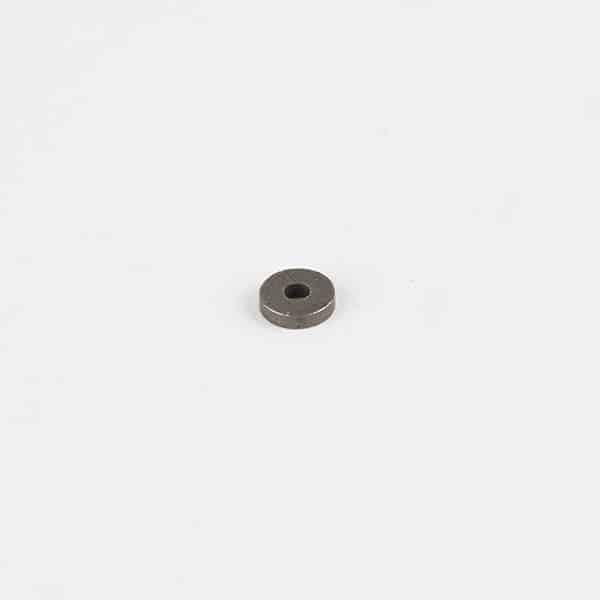Alnico magnet was successfully developed in the 1930s. It is composed of aluminum, nickel, cobalt, iron, and other trace metal elements. Thanks to their high coercivity and high Curie temperature, Alnico magnets are widely used in many industrial and consumer products, such as motors, electric guitar pickups, microphones, sensors, speakers, traveling wave tubes, and so on. But how are Alnico magnets made, do you know? In this article, let’s take a deeper look at the process of producing Alnico magnets.
Before diving into our article, let’s figure out how many types of Alnico magnets out there.
Alnico magnets aren't as strong as rare earth magnets, but they withstand the highest temperatures. Magnets come with a keeper that covers the poles to preserve the strength of the magnet and protect it from attracting metal during storage. Warning: Maximum pull ratings are based on direct contact with rust-free and unpainted iron plate. AlNiCo Magnets are made of the alloy of Aluminum-Nickel-Cobalt which possesses excellent temperature stability and high residual induction. AlNiCo magnets have a low coercive force that limits their applications in many cases. Casting and sintering are two major processes used to manufacture the AlNiCo magnets. The Strength of Alnico Magnets. Alnico has a high magnetic strength and a low resistance to being demagnetized and re-magnetized. Before the development of rare earth magnets, alnico magnets were the strongest type of magnet available. Today, alnico magnets have been largely replaced by stronger rare earth magnets, such as neodymium.
Alnico Magnets 160 products Check out a huge selection of strong magnets at Grainger for use in a multitude of industrial and commercial applications. Ceramic block magnets can be used in separation, holding, sweeper applications and more.

Alnico magnets can be produced by two methods, one by sintering and the other, more generally, by using a casting process. The density and mass of the Alnico magnets made by casting are larger so they have better magnetic characteristics and performance compared with the ones produced by sintering. But sintered Alnico magnets are more economical to produce. Besides, both anisotropic and isotropic variations of Alnico magnets can be achieved by sintering or casting.
When larger Alnico magnets weighing tens of kilograms are needed, then they will nearly always be made by casting method. However, really small Alnico magnets that weigh grams rather than kilograms are usually produced by using the sintering process. Sintering is usually the process used when a high volume of magnets are required.
Without further ado, let’s take a look at the steps of producing these two types of magnets.
The Steps of Producing Cast Alnico Magnets
Step one – Foundry Furnace
Different grades of Alnico have different recipes in terms of the percentage of aluminum, nickel, cobalt, and iron used. Quantities of the individual elements are placed in an induction furnace and are melted at a temperature of above 1750 degrees Celsius. There is more aluminum added than required to form the final magnet because some of the aluminum is wasted as it melts at a lower temperature (usually around 680 degrees Celsius).
During the melting and before casting, samples are taken, cooled, and analyzed with an x-ray spectrometer to make sure that the exact ratios of materials are correct and to allow any last-minute adjustments to be made.
Step Two – Casting
Pour the molten material into a shell mold or a larger green sand mold. As the molten metal cools, the shell mold starts to burn, and when the magnet becomes cold, the shell almost disintegrates. A shell mold is made by using a pattern plate and a molding machine.
The size of the patterns is similar to the required magnet size, but with an additional allowance for shrinkage and machining size. The internal magnetic cavities are connected by runners and these runners allow molten metal to reach each magnet cavity. Once the magnet is cast, these runners will be scrapped and remelted.
Step Three – Fettling
After that, the newly cast magnets are harvested from the molds and are then fettled on grinding wheels in order to remove the runner gates.
Step Four – Heat Treatment
The magnets are then heated to a very high temperature and placed in a magnetizer so that they can begin to cool down in a very strong magnetic field. This process is called hardening the magnet.
Then place the magnets in large tempering ovens for several days to temper and stabilize the magnets.
The heat treatment stage of the process, together with the foundry mix of alloys, makes the magnetic material have temperature handling characteristics and final magnetic properties.
Step Five – Grinding
Magnets usually need to be ground to a tight tolerance. Because the magnets are very hard, this is done by grinding.
Step Six – Testing
You can use a hysteresis graph tester, a Gauss meter, or a flux meter to test Alnico magnets.
Step Seven – Coating/Painting
If a specific coating is needed, this is done at the end of the process. The poles of the magnets may be fettled in order to make them bright and shiny.
Step Eight – Magnetising
The magnets are inserted into a coil or solenoid magnetizer, and within one-fifth of a second, an electrical pulse will generate the necessary magnetic field to fully magnetize the magnets.
The Steps of Producing Sintered Alnico Magnets
Step One – Pressing
The raw elements must be finely ground by milling into fine particles before sintered Alnico magnets are produced. The powdered magnetic material is then pressed into a die under a pressure of several tonnes, which closely resembles the magnets’ desired shape.
Step Two – Sintering

After the powder has been pressed, the material is sintered at a temperature above 1200°C in a furnace in a hydrogen atmosphere. This process fuses all the compressed particles together to form a magnet.
Step Three – Cooling Android igo primo apk.
Then the red hot material is cooled. At this point, the material will have anisotropic properties and a preferred magnetic direction if it is cooled in the presence of an external magnetic field, which makes it stronger. Otherwise, if no external magnetic field is applied, the resulting magnet will be isotropic without a preferential direction of magnetism.
Step Four – Coating

Typically, sintered Alnico magnets do not need further shaping or machining because the dies they are pressed into is very close to the required magnet shape. If a specific coating is needed, this can be done at the end of the process, just before the final magnetization of the magnets. To make the poles of the magnets bright and shiny, they can be fettled.

Step Five – Magnetising
At last, the raw magnetic material is placed in a coil or solenoid magnetizer for magnetization and then within one-fifth of a second, an electrical pulse generates the necessary field required to fully magnetize the magnet.
Conclusion
Thank you for reading our article and we hope it can help you to find the answer to the question of how are Alnico magnets made. If you want to know more about Alnico magnets and other types of magnets, we would like to advise you to visit Stanford Magnets for more information.

As a leading magnet supplier across the world, Stanford Magnets has been involved in R&D, manufacturing, and sales of magnets since the 1990s. It provides customers with high-quality permanent magnets like neodymium magnets, SmCo magnets, AlNiCo magnets, and ferrite magnets (ceramic magnets) at a very competitive price.
One of our favorite applications is magnets for pickups. There are many things to consider if you are looking to optimize your guitar to its full potential, and pickups are arguably one of the most important elements of customization. If you are a skilled designer of pickups looking to create the best sound from your instrument, you have a choice between alnico and ceramic magnets when it comes to magnetic guitar pickups.
Adams Magnetic Products supports the music industry every day by supplying high-quality alnico and ceramic magnets for every style pickup made. Select from our stock sizes, or we can produce to your exact specifications.
Before we dive into the details, let’s answer the casual surfer here by answering: what is a magnet pickup even made of? Basically, pickups consist of magnets and wires. However, the way in which these components work together is rather complicated. A length of wire is first coiled around the magnet, which creates a magnetic field. Whenever a string vibrates in that field, the coil detects field changes and then creates a voltage, thus producing that perfect sound. As far as the resources that go into making the magnets, that where Adams steps in.
Alnico Magnets Meaning
Probably the biggest variables that influence the decision between alnico and ceramic magnets for guitar pickups are their specific uses or effects sought within the realm of pickups. Let’s start with alnico. They are known to be very strong and durable, which is what many pickup manufacturers love about them. Because of this, they are also used for things such as loudspeakers and motors. But any seasoned musician will argue that its best purpose is served planted into the pickup of your guitar. These durable magnets are known for a smooth, melodic sound when it comes to the tone of the instrument, and different from the sound of the circuit created with ceramic magnets.
Alnico Magnets Properties
Alnico Magnets for Pickups
Alnico Magnets History
Alnico magnets come in three main grades: 2, 3, and 5:
- Alnico 2 traces back to the days of the 1950 Telecasters. This class seems to work well for middle-position pickups. It is known by its sweet, vintage tone, and there seem to be little disadvantages to using it.
- Alnico 3 is the weakest of the three grades. It contains less cobalt, a core ingredient in the rest of the Alnico family. Because of the decrease in magnetic pull, it works wonders for neck pickups, where there is the most string vibration.
- Alnico 5 is the strongest of the three alnico grades. The tone and response of the magnet is more powerful than its two cousins. This makes it perfect for bridge pickups, where there is the least vibration. If you want an aggressive, in-your-face kind of sound, Alnico 5 is your best bet.
Alnico Magnets For Sale
To learn see examples and more data about alnico magnets for pickups, visit our alnico rods page.
